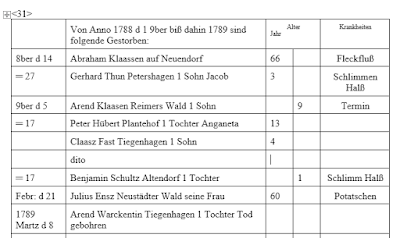You could use any handwritten German document; but this one is written clearly; and even more importantly, John Thiesen has made an exact transcription. So we can compare the handwritten German text to the typewritten transcription.
At this point, we're only interested in reading the letters and words, not yet about understanding the meaning.
Let's download a random page from the church book, p. 30-31. Then download John Thiesen's transcription for comparison - it's a large Word document, so be patient - and find page 31. We'll use the righthand page, page 31, because it has more Kurrentschrift on it than the lefthand side. (Note that personal names are usually written in Latin script not Kurrentschrift.) Start at the top and look at the Latin transcription and follow the Kurrentschrift.
Did you see that one of the column headings is missing in the transcription? Can you figure out the word on your own? (Answer at the end.)
 |
| Portion of transcription of page 31. |
Congratulations - you've made your first step into reading a real genealogical document!
ANSWER - The missing word is "Wochen," which means "weeks."

No comments:
Post a Comment